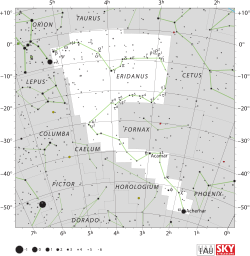Tau6 Eridani
| Tau6 Eridani (τ6) | |
 | |
| Observationsdata Epok: J2000.0 | |
|---|---|
| Stjärnbild | Eridanus |
| Rektascension | 03t 46m 50,88819s[1] |
| Deklination | -23° 14′ 59,0046″[1] |
| Skenbar magnitud () | +4,22[2] |
| Stjärntyp | |
| Spektraltyp | F5 IV-V[3] |
| B–V | +0,43[2] |
| Astrometri | |
| Radialhastighet () | 8,0 ± 0,8[4] km/s |
| Egenrörelse (µ) | RA: -158,84[1] mas/år Dek.: -528,95[1] mas/år |
| Parallax () | 56,73 ± 0,19[1] |
| Avstånd | 57,5 ± 0,2 lå (17,63 ± 0,06 pc) |
| Absolut magnitud () | 2,98[5] |
| Detaljer | |
| Massa | 1,35[4] M☉ |
| Radie | 1,6[6] R☉ |
| Luminositet | 3,0[7] L☉ |
| Temperatur | 6 508 ± 82[4] K |
| Metallicitet | -0,03 ± 0,11[4] dex |
| Vinkelhastighet | 16,25[8] km/s |
| Ålder | 2,0[4] miljarder år |
| Andra beteckningar | |
| τ6 Eridani, τ6 Eri, 27 Eridani, CD-23° 1565, FK5 140, GJ 155, HD 23754, HIP 17651, HR 1173, SAO 168827. [9] | |
Tau6 Eridani (τ6 Eridani, förkortat Tau6 Eri, τ6 Eri) som är stjärnans Bayerbeteckning, är en ensam stjärna belägen i den mellersta delen av stjärnbilden Eridanus. Den har en skenbar magnitud på 4,22[2], är synlig för blotta ögat där ljusföroreningar ej förekommer. Baserat på parallaxmätning inom Hipparcosuppdraget på ca 56,7[1] mas, beräknas den befinna sig på ett avstånd på ca 58 ljusår (ca 18 parsek) från solen.
Egenskaper[redigera | redigera wikitext]
Tau6 Eridani är en gul till vit stjärna i huvudserien av spektralklass F5 IV-V[3], men uppvisar även egenskaper för en underjättestjärna. Den har en massa som är ca 35[4] procent större än solens massa, en radie som är ca 60[6] procent större än solens och utsänder från dess fotosfär ca 3[7] gånger mera energi än solen vid en effektiv temperatur på ca 6 500[4] K.
Tau6 Eridani har undersökts med avseende på överskott av infraröd strålning, som kan indikera närvaron av omgivande stoft, men inget sådant har detekterats.[10]
Källor[redigera | redigera wikitext]
- Den här artikeln är helt eller delvis baserad på material från engelskspråkiga Wikipedia, tidigare version.
Referenser[redigera | redigera wikitext]
- ^ [a b c d e f] van Leeuwen, F. (2007), "Validation of the new Hipparcos reduction", Astronomy and Astrophysics, 474 (2): 653–664, arXiv:0708.1752 , Bibcode:2007A&A...474..653V, doi:10.1051/0004-6361:20078357.
- ^ [a b c] Mermilliod, J.-C. (1986), Compilation of Eggen's UBV data, transformed to UBV (unpublished), SIMBAD, Bibcode:1986EgUBV........0M.
- ^ [a b] Gray, R. O.; et al. (July 2006), "Contributions to the Nearby Stars (NStars) Project: spectroscopy of stars earlier than M0 within 40 pc-The Southern Sample", The Astronomical Journal, 132 (1): 161–170, arXiv:astro-ph/0603770 , Bibcode:2006AJ....132..161G, doi:10.1086/504637.
- ^ [a b c d e f g] Kordopatis, G.; Gilmore, G.; Steinmetz, M.; Boeche, C.; Seabroke, G. M.; Siebert, A.; Zwitter, T.; Binney, J.; et al. (November 2013), "The Radial Velocity Experiment (RAVE): Fourth Data Release", The Astronomical Journal, 146 (5): 36, arXiv:1309.4284 , Bibcode:2013AJ....146..134K, doi:10.1088/0004-6256/146/5/134, 134.
- ^ Reiners, A. (January 2006), "Rotation- and temperature-dependence of stellar latitudinal differential rotation", Astronomy and Astrophysics, 446 (1): 267–277, arXiv:astro-ph/0509399 , Bibcode:2006A&A...446..267R, doi:10.1051/0004-6361:20053911.
- ^ [a b] Pasinetti Fracassini, L. E.; et al. (February 2001), "Catalogue of Apparent Diameters and Absolute Radii of Stars (CADARS) - Third edition - Comments and statistics", Astronomy and Astrophysics, 367 (2): 521–524, arXiv:astro-ph/0012289 , Bibcode:2001A&A...367..521P, doi:10.1051/0004-6361:20000451.
- ^ [a b] https://www.universeguide.com/star/tau6eridani. Hämtad 2018-02-18.
- ^ Martínez-Arnáiz, R.; et al. (September 2010), "Chromospheric activity and rotation of FGK stars in the solar vicinity. An estimation of the radial velocity jitter", Astronomy and Astrophysics, 520: A79, arXiv:1002.4391 , Bibcode:2010A&A...520A..79M, doi:10.1051/0004-6361/200913725.
- ^ "* tau06 Eri". SIMBAD. Centre de données astronomiques de Strasbourg. Hämtad 2016-10-13.
- ^ Weinberger, Alycia J.; Bryden, Geoff; Kennedy, Grant M.; Roberge, Aki; Defrère, Denis; Hinz, Philip M.; Millan-Gabet, Rafael; Rieke, George; et al. (February 2015), "Target Selection for the LBTI Exozodi Key Science Program", The Astrophysical Journal Supplement Series, 216 (2): 8, arXiv:1501.01319 , Bibcode:2015ApJS..216...24W, doi:10.1088/0067-0049/216/2/24, 24.





